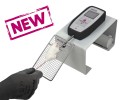Authors
J. J. Luszczki, N. Ratnaraj, P. N. Patsalos, S. J. Czuczwar.
Lab
Medical University of Lublin, Department of Pathophysiology, and Institute of Agricultural Medicine, Department of Physiopathology, Lublin, Poland ; Institute of Neurology, Department of Clinical and Experimental Epilepsy, Pharmacology and Therapeutics Un
Journal
Epilepsia
Abstract
Purpose: Isobolographic analysis was used to characterize the interactions between stiripentol (STP) and clonazepam (CZP), ethosuximide (ETS), phenobarbital (PB), and valproate (VPA) in suppressing pentylenetetrazole (PTZ)-induced clonic seizures in mice. Methods: The anticonvulsant and acute adverse (neurotoxic) effects of STP in combination with the various conventional antiepileptic drugs (AEDs), at fixed ratios of 1:3, 1:1, and 3:1, were evaluated in the PTZ and chimney tests in mice using the isobolographic analysis. Additionally, protective indices (PI) and benefit indices (BI) were calculated to identify their pharmacological profiles so that a ranking in relation to advantageous combination could be established. Moreover, adverse-effect paradigms were determined by use of the step-through passive avoidance task (long-term memory), threshold for the first pain reaction, grip-strength test (neuromuscular tone), and the hot plate test (acute thermal pain). Brain AED concentrations were also measured so as to ascertain any pharmacokinetic contribution to the pharmacodynamic interactions. Results: All AED combinations comprising of STP and CZP, ETS, PB, and VPA (at the fixed ratios of 1:3, 1:1 and 3:1) were additive in terms of clonic seizure suppression in the PTZ test. However, these interactions were complicated by changes in brain AED concentrations consequent to pharmacokinetic interactions. Thus STP significantly increased total brain ETS and PB concentrations, and decreased VPA concentrations, but was without effect on CZP concentrations. In contrast, PB significantly decreased and VPA increased total brain STP concentrations while CZP and ETS were without effect. Furthermore, while isobolographic analysis revealed that STP and CZP in combination, at the fixed ratios of 1:1 and 3:1, were supraadditive (synergistic; p < 0.05), the combinations of STP with CZP (1:3), ETS, PB, or VPA (at all fixed ratios of 1:3, 1:1, and 3:1) were barely additivity in terms of acute neurotoxic adverse effects in the chimney test. Additionally, none of the examined combinations of STP with conventional AEDs (CZP, ETS, PB, VPA—at their median effective doses from the PTZ-test) affected long-term memory, threshold for the first pain reaction, neuromuscular tone, and acute thermal pain. Conclusions: Based on BI values, the combination of STP with PB at the fixed ratio of 1:3 appears to be a particularly favourable combination. In contrast, STP and CZP or ETS (at the fixed ratios of 1:1 and 3:1) were unfavorable combinations. However, these conclusions are confounded by the fact that STP is associated with significant pharmacokinetic interactions. The remaining combinations of STP with PB (1:1 and 3:1), CZP (1:3), ETS (1:3), and VPA (at all fixed ratios of 1:3, 1:1, and 3:1) do not appear to be potential favorable AED combinations.
BIOSEB Instruments Used:
Grip strength test (BIO-GS3)

 Douleur - Allodynie/Hyperalgésie Thermique
Douleur - Allodynie/Hyperalgésie Thermique Douleur - Spontanée - Déficit de Posture
Douleur - Spontanée - Déficit de Posture Douleur - Allodynie/Hyperalgésie Mécanique
Douleur - Allodynie/Hyperalgésie Mécanique Apprentissage/Mémoire - Attention - Addiction
Apprentissage/Mémoire - Attention - Addiction Physiologie & Recherche Respiratoire
Physiologie & Recherche Respiratoire
 Douleur
Douleur Système Nerveux Central (SNC)
Système Nerveux Central (SNC)  Neurodégénérescence
Neurodégénérescence Système sensoriel
Système sensoriel Système moteur
Système moteur Troubles de l'humeur
Troubles de l'humeur Autres pathologies
Autres pathologies Système musculaire
Système musculaire Articulations
Articulations Métabolisme
Métabolisme Thématiques transversales
Thématiques transversales SFN2024: Venez rencontrer notre équipe sur le stand 876 à Chicago
SFN2024: Venez rencontrer notre équipe sur le stand 876 à Chicago 